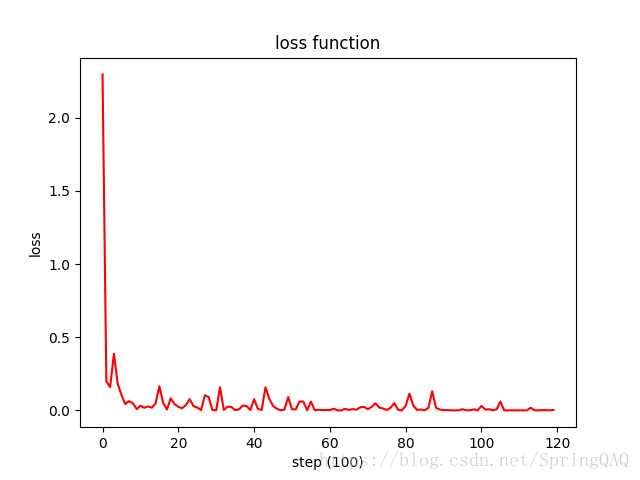import torch
import torch.nn as nn
import torchvision.datasets as dsets
import torchvision.transforms as transforms
import matplotlib.pyplot as plt
import numpy as np
batch_size = 50
# MNIST dataset
train_dataset = dsets.MNIST(root='../../data_sets/mnist', # 选择数据的根目录
train=True, # 选择训练集
transform=transforms.ToTensor(), # 转换成tensor变量
download=False) # 不从网络上download图片
test_dataset = dsets.MNIST(root='../../data_sets/mnist', # 选择数据的根目录
train=False, # 选择训练集
transform=transforms.ToTensor(), # 转换成tensor变量
download=False) # 不从网络上download图片
# 加载数据
train_loader = torch.utils.data.DataLoader(dataset=train_dataset,
batch_size=batch_size,
shuffle=True) # 将数据打乱
test_loader = torch.utils.data.DataLoader(dataset=test_dataset,
batch_size=batch_size,
shuffle=True)
class Net(torch.nn.Module):
def __init__(self):
super(Net, self).__init__()
self.conv1 = nn.Sequential(
nn.Conv2d(1, 16, 5, 1, 2), # 10 *32 *32 out = 16*28*28
nn.ReLU(),
nn.MaxPool2d(2) # 16*14*14
) # output 10*
self.conv2 = nn.Sequential(
nn.Conv2d(16, 32, 5, 1, 2), # 10 × 18 x 18-> 14 *14 * 32
nn.ReLU(),
nn.MaxPool2d(2) # 32*7*7
)
self.out = nn.Linear(32 * 7 * 7, 10)
def forward(self, x):
x = self.conv1(x)
x = self.conv2(x)
x = x.view(x.size(0), -1)
x = self.out(x)
return x
# define the neural net
net = Net()
if torch.cuda.is_available():
net.cuda()
optimizer = torch.optim.SGD(net.parameters(), lr=0.0510) # 0.052
optimizer = torch.optim.Adam(net.parameters(), lr=0.001)
loss_func = torch.nn.CrossEntropyLoss()
loss_numpy = np.array([])
for epoch in range(10):
for i, (images, labels) in enumerate(train_loader): # 利用enumerate取出一个可迭代对象的内容
images = images.reshape(50, 1, 28, 28)
labels = labels
if torch.cuda.is_available():
images = images.cuda()
labels = labels.cuda()
# print(images.size())
out = net(images)
loss = loss_func(out, labels)
optimizer.zero_grad()
loss.backward()
optimizer.step()
if i % 100 == 0:
print('current loss = %.5f' % loss.item())
loss_numpy = np.insert(loss_numpy, loss_numpy.size, loss.item())
with torch.no_grad():
correct = 0
total = 0
for images, labels in test_loader:
images = images.reshape(50, 1, 28, 28)
labels = labels
if torch.cuda.is_available():
images = images.cuda()
labels = labels.cuda()
output_t = net(images)
_, predicted = torch.max(output_t.data, 1)
total += labels.size(0)
correct += (predicted == labels).sum().item()
print('Accuracy of the network on the 10000 test images: {} %'.format(100 * correct / total))
plt.plot(loss_numpy, 'r-', )
plt.title('loss function', fontsize='large')
plt.xlabel('step (100)')
plt.ylabel('loss')
plt.show()
准确率:Accuracy of the network on the 10000 test images: 99.1 %
损失函数:

最后
以上就是义气百褶裙最近收集整理的关于CNN 卷积神经网络实践(基于Mnist数据集)的全部内容,更多相关CNN内容请搜索靠谱客的其他文章。
本图文内容来源于网友提供,作为学习参考使用,或来自网络收集整理,版权属于原作者所有。








发表评论 取消回复